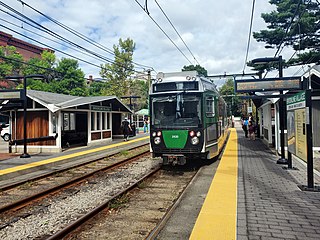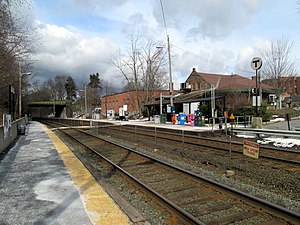
The MBTA Commuter Rail system serves as the commuter rail arm of the Massachusetts Bay Transportation Authority's (MBTA's) transportation coverage of Greater Boston in the United States. Trains run over 394 mi (634 km) of track to 135 stations. It is operated under contract by Keolis, which took over operations on July 1, 2014, from the Massachusetts Bay Commuter Railroad Company (MBCR).

The Boston and Albany Railroad was a railroad connecting Boston, Massachusetts to Albany, New York, later becoming part of the New York Central Railroad system, Conrail, and CSX Transportation. The mainline is currently used by CSX for freight as the Berkshire Subdivision and Boston Subdivision. Passenger service is provided on the line by Amtrak, as part of their Lake Shore Limited service, and by the MBTA Commuter Rail system, which owns the section east of Worcester and operates it as its Framingham/Worcester Line.

The Framingham/Worcester Line of the MBTA Commuter Rail system runs west from Boston, Massachusetts, to Worcester, Massachusetts, through the MetroWest region, serving 18 station stops in Boston, Newton, Wellesley, Natick, Framingham, Ashland, Southborough, Westborough, Grafton, and Worcester. It is the third-longest and third-busiest line in the MBTA Commuter Rail system. Service on the line is a mix of local and express trains serving Worcester plus short-turn Framingham locals.

Brookline Village station is a light rail station on the MBTA Green Line D branch, located in the Brookline Village neighborhood of Brookline, Massachusetts, United States. It was originally a commuter rail station on the Boston and Albany Railroad's Highland branch; it closed with the rest of the line in 1958 and reopened on July 4, 1959 as a light rail station. With 3,230 daily boardings, it is the third-busiest surface station on the D branch and the sixth-busiest surface station overall. Brookline Village station has raised platforms for accessibility with low-floor light rail vehicles.

Union Station, also known as Walpole station, is an MBTA Commuter Rail station in Walpole, Massachusetts. It is located at the crossing of the Franklin Branch and Framingham Secondary just west of downtown Walpole. The station has one side platform on the Franklin Branch serving the Franklin/Foxboro Line service. Unlike most MBTA stations, Walpole station is not accessible; an accessible platform is under construction.

Natick Center station is an MBTA Commuter Rail station in Natick, Massachusetts served by the Framingham/Worcester Line. The station, located below grade in a wide cut adjacent to North Main Street, has two side platforms serving the line's two tracks. The second-busiest non-accessible station on the system, it is undergoing a major accessibility renovation and modernization from 2020 to 2025.

Woodland station is a light rail stop on the MBTA Green Line D branch, located off Washington Street (MA-16) between the Newton Lower Falls and Auburndale villages of Newton, Massachusetts, United States. It serves as access to the Newton-Wellesley Hospital, as well as a park and ride station for nearby Route 128.

Wellesley Farms station is an MBTA Commuter Rail station in Wellesley, Massachusetts. It serves the Framingham/Worcester Line. It is located in the Wellesley Farms area. The current station building, designed by Henry Hobson Richardson in 1886 and constructed in 1890, has been listed on the U.S. National Register of Historic Places as Wellesley Farms Railroad Station since 1986.

Brookline Hills station is a light rail station on the Massachusetts Bay Transportation Authority (MBTA) Green Line D branch in the Brookline Hills neighborhood of Brookline, Massachusetts. The station has two side platforms serving the line's two tracks. It was closed from April 2021 to January 2022 as part of adjacent construction on a Brookline High School building, which included renovations to make the station accessible.

Newtonville station is a commuter rail station on the MBTA Commuter Rail Framingham/Worcester Line, located between the Massachusetts Turnpike and Washington Street at Newtonville Square in the village of Newtonville in Newton, Massachusetts. Stairway entrances are located on the bridges over the Turnpike at Walnut Street and Harvard Street. Newtonville station is not accessible; renovations for accessibility are planned.

West Newton station is an MBTA Commuter Rail station in Newton, Massachusetts. It serves the Framingham/Worcester Line, and is located inside the Massachusetts Turnpike Exit 16 rotary in the village of West Newton. West Newton has had continuous rail service since 1834. The station consists of a single low side platform serving one of the line's two tracks, with small crossings to access trains on the far track. West Newton is not accessible; a renovation for accessibility is planned.

Auburndale station is an MBTA Commuter Rail station in Auburndale, Massachusetts. It serves the Framingham/Worcester Line. It is located next to the Massachusetts Turnpike near Lasell College. The modern station platform, built around 1961, replaced a highly acclaimed 1881 depot building designed by H. H. Richardson. A full renovation of the station for accessibility is planned.

Wellesley Square station is a commuter rail station on the MBTA Commuter Rail Framingham/Worcester Line, located just north of the MA 16-MA 135 intersection in downtown Wellesley, Massachusetts. It serves both walk-up and park-and-ride commuters, with a 224-space parking lot for the latter group. The station has low-level platforms and is not accessible; accessible mini-high platforms are under construction.

West Natick station is a commuter rail station on the MBTA Commuter Rail Framingham/Worcester Line, located off West Central Street (MA-135) in Natick, Massachusetts. It was opened in 1982 as a park and ride station.

Westborough station is an MBTA Commuter Rail station in Westborough, Massachusetts. It serves the Framingham/Worcester Line. It is located off Smith Parkway, west of the Westborough town center. The station consists of two side platforms serving the line's two tracks. Each side has a small mini-high platform for accessibility; an overhead ramp structure connects the two platforms.

Grafton station is an MBTA Commuter Rail station in the North Grafton village of Grafton, Massachusetts, served by the Framingham/Worcester Line. The station is fully accessible, with mini-high platforms serving both of the line's two tracks.

Chestnut Hill station is a light rail station on the MBTA Green Line D branch, located off Hammond Street north of Massachusetts Route 9 in the Chestnut Hill neighborhood of Newton, Massachusetts. The station has two side platforms serving the line's two tracks. Chestnut Hill station was made accessible in October 2024; additional reconstruction is planned to begin in 2026.

Framingham station is a historic Boston and Albany Railroad station located in downtown Framingham, Massachusetts. Designed by noted American architect H. H. Richardson, it was one of the last of the railroad stations he designed in the northeastern United States to be built. The station, built in 1884–85, served as a major stop on the B&A Main Line as well as a hub for branch lines to Milford, Mansfield, Fitchburg, and Lowell. After years of deterioration, the station was listed on the National Register of Historic Places in 1975 as the Framingham Railroad Station, and restored a decade later.

Union Station is a railway station located at Washington Square in downtown Worcester, Massachusetts. It is the western terminus of the MBTA Commuter Rail Framingham/Worcester Line and a stop for the Amtrak Lake Shore Limited service. A bus terminal adjacent to the station is the hub for Worcester Regional Transit Authority (WRTA) local bus service; it is also used by PVTA, MART, Peter Pan, and Greyhound intercity buses.

Boston Landing station is an MBTA Commuter Rail station in Boston, Massachusetts, United States. It is served by the Framingham/Worcester Line. It is located in the Brighton neighborhood just west of the Everett Street bridge, next to the Massachusetts Turnpike. It serves the Allston-Brighton area as well as the Boston Landing development including Warrior Ice Arena. The station is fully accessible, with a single full-length high-level island platform. Elevators and stairs lead to Arthur Street and to the Everett Street bridge.






















